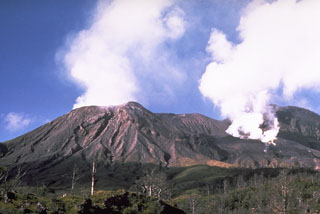Report on Langila (Papua New Guinea) — January 1993
Bulletin of the Global Volcanism Network, vol. 18, no. 1 (January 1993)
Managing Editor: Lindsay McClelland.
Langila (Papua New Guinea) Ash ejections and glow continue
Please cite this report as:
Global Volcanism Program, 1993. Report on Langila (Papua New Guinea) (McClelland, L., ed.). Bulletin of the Global Volcanism Network, 18:1. Smithsonian Institution. https://doi.org/10.5479/si.GVP.BGVN199301-252010
Langila
Papua New Guinea
5.525°S, 148.42°E; summit elev. 1330 m
All times are local (unless otherwise noted)
"Activity remained at a moderate level in January, very similar to the activity in December. Emissions from Crater 2 consisted of weak-to-moderate white vapour-and-ash clouds. Occasionally, forceful emissions of thick dark-grey ash-laden clouds formed a column several hundred metres high at the summit. Explosion and rumbling sounds usually accompanied these Vulcanian explosions. Fine ashfalls were reported on the SE side of the volcano on a few days. A steady, weak night glow was seen over the crater during the second half of the month, with incandescent Strombolian projections to 100 m on 23-24 January. Activity at Crater 3 was at a very low level throughout the month, consisting only of the gentle release of small volumes of white vapour, with some blue vapour 30-31 January. Seismicity remained low, with only a few explosion earthquakes recorded daily."
Geological Summary. Langila, one of the most active volcanoes of New Britain, consists of a group of four small overlapping composite basaltic-andesitic cones on the lower E flank of the extinct Talawe volcano in the Cape Gloucester area of NW New Britain. A rectangular, 2.5-km-long crater is breached widely to the SE; Langila was constructed NE of the breached crater of Talawe. An extensive lava field reaches the coast on the N and NE sides of Langila. Frequent mild-to-moderate explosive eruptions, sometimes accompanied by lava flows, have been recorded since the 19th century from three active craters at the summit. The youngest and smallest crater (no. 3 crater) was formed in 1960 and has a diameter of 150 m.
Information Contacts: R. Stewart, P. de Saint-Ours, and C. McKee, RVO.

